ACC 4113: EMA Implementation & Organizational Change in Hotels
VerifiedAdded on 2023/06/20
|21
|7283
|402
Case Study
AI Summary
This case study analyzes the implementation of Environmental Management Accounting (EMA) at a hotel in Sri Lanka, focusing on how the hotel adopted EMA, achieved cost savings through conservation efforts, and integrated EMA approaches into its daily operations. The hotel, facing financial challenges due to decreased tourism, implemented an eco-control framework to enhance its green hotel concept and save costs. Key initiatives included energy and water conservation, waste reduction, and biodiversity preservation. The hotel set specific environmental goals, such as saving water and energy, reducing pollution, and increasing recycling practices. Through measures like installing solar panels, using water-saving cisterns, and implementing waste management strategies, the hotel achieved significant cost savings and improved its environmental performance. The case study also highlights the importance of internal and external communication in promoting eco-friendly practices and engaging stakeholders. The EMA practices have become ingrained in the organization's culture, contributing to both environmental sustainability and financial stability.
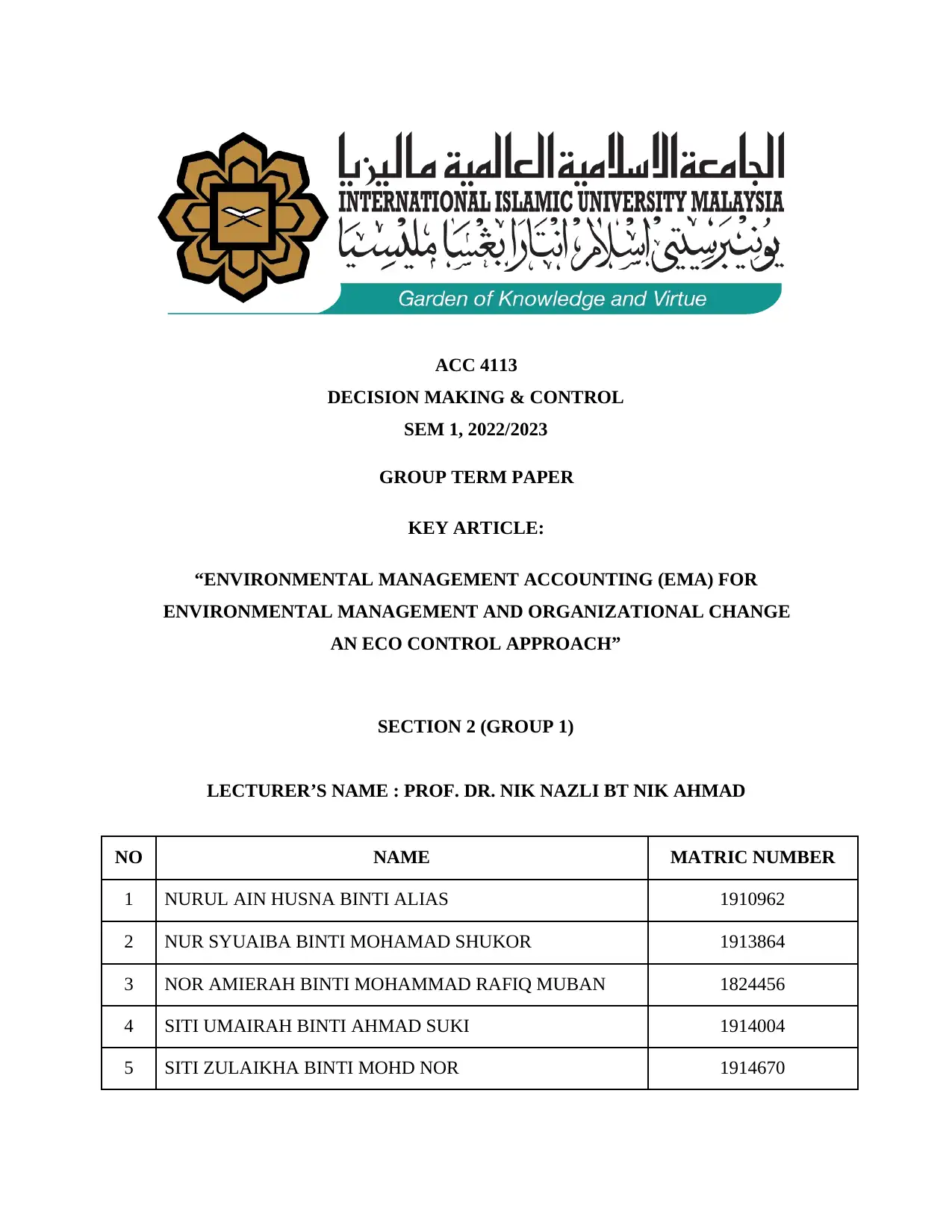
ACC 4113
DECISION MAKING & CONTROL
SEM 1, 2022/2023
GROUP TERM PAPER
KEY ARTICLE:
“ENVIRONMENTAL MANAGEMENT ACCOUNTING (EMA) FOR
ENVIRONMENTAL MANAGEMENT AND ORGANIZATIONAL CHANGE
AN ECO CONTROL APPROACH”
SECTION 2 (GROUP 1)
LECTURER’S NAME : PROF. DR. NIK NAZLI BT NIK AHMAD
NO NAME MATRIC NUMBER
1 NURUL AIN HUSNA BINTI ALIAS 1910962
2 NUR SYUAIBA BINTI MOHAMAD SHUKOR 1913864
3 NOR AMIERAH BINTI MOHAMMAD RAFIQ MUBAN 1824456
4 SITI UMAIRAH BINTI AHMAD SUKI 1914004
5 SITI ZULAIKHA BINTI MOHD NOR 1914670
DECISION MAKING & CONTROL
SEM 1, 2022/2023
GROUP TERM PAPER
KEY ARTICLE:
“ENVIRONMENTAL MANAGEMENT ACCOUNTING (EMA) FOR
ENVIRONMENTAL MANAGEMENT AND ORGANIZATIONAL CHANGE
AN ECO CONTROL APPROACH”
SECTION 2 (GROUP 1)
LECTURER’S NAME : PROF. DR. NIK NAZLI BT NIK AHMAD
NO NAME MATRIC NUMBER
1 NURUL AIN HUSNA BINTI ALIAS 1910962
2 NUR SYUAIBA BINTI MOHAMAD SHUKOR 1913864
3 NOR AMIERAH BINTI MOHAMMAD RAFIQ MUBAN 1824456
4 SITI UMAIRAH BINTI AHMAD SUKI 1914004
5 SITI ZULAIKHA BINTI MOHD NOR 1914670
Paraphrase This Document
Need a fresh take? Get an instant paraphrase of this document with our AI Paraphraser
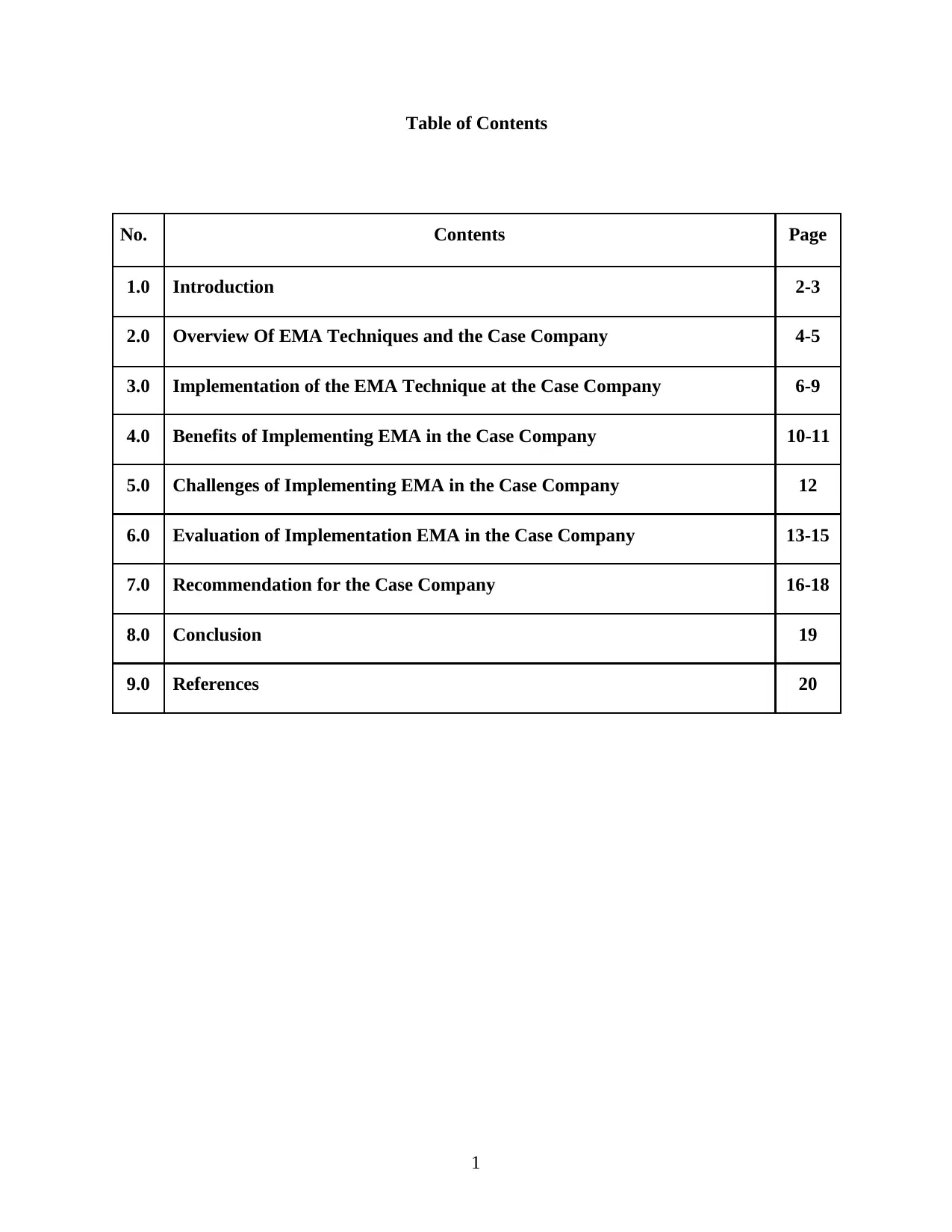
Table of Contents
No. Contents Page
1.0 Introduction 2-3
2.0 Overview Of EMA Techniques and the Case Company 4-5
3.0 Implementation of the EMA Technique at the Case Company 6-9
4.0 Benefits of Implementing EMA in the Case Company 10-11
5.0 Challenges of Implementing EMA in the Case Company 12
6.0 Evaluation of Implementation EMA in the Case Company 13-15
7.0 Recommendation for the Case Company 16-18
8.0 Conclusion 19
9.0 References 20
1
No. Contents Page
1.0 Introduction 2-3
2.0 Overview Of EMA Techniques and the Case Company 4-5
3.0 Implementation of the EMA Technique at the Case Company 6-9
4.0 Benefits of Implementing EMA in the Case Company 10-11
5.0 Challenges of Implementing EMA in the Case Company 12
6.0 Evaluation of Implementation EMA in the Case Company 13-15
7.0 Recommendation for the Case Company 16-18
8.0 Conclusion 19
9.0 References 20
1
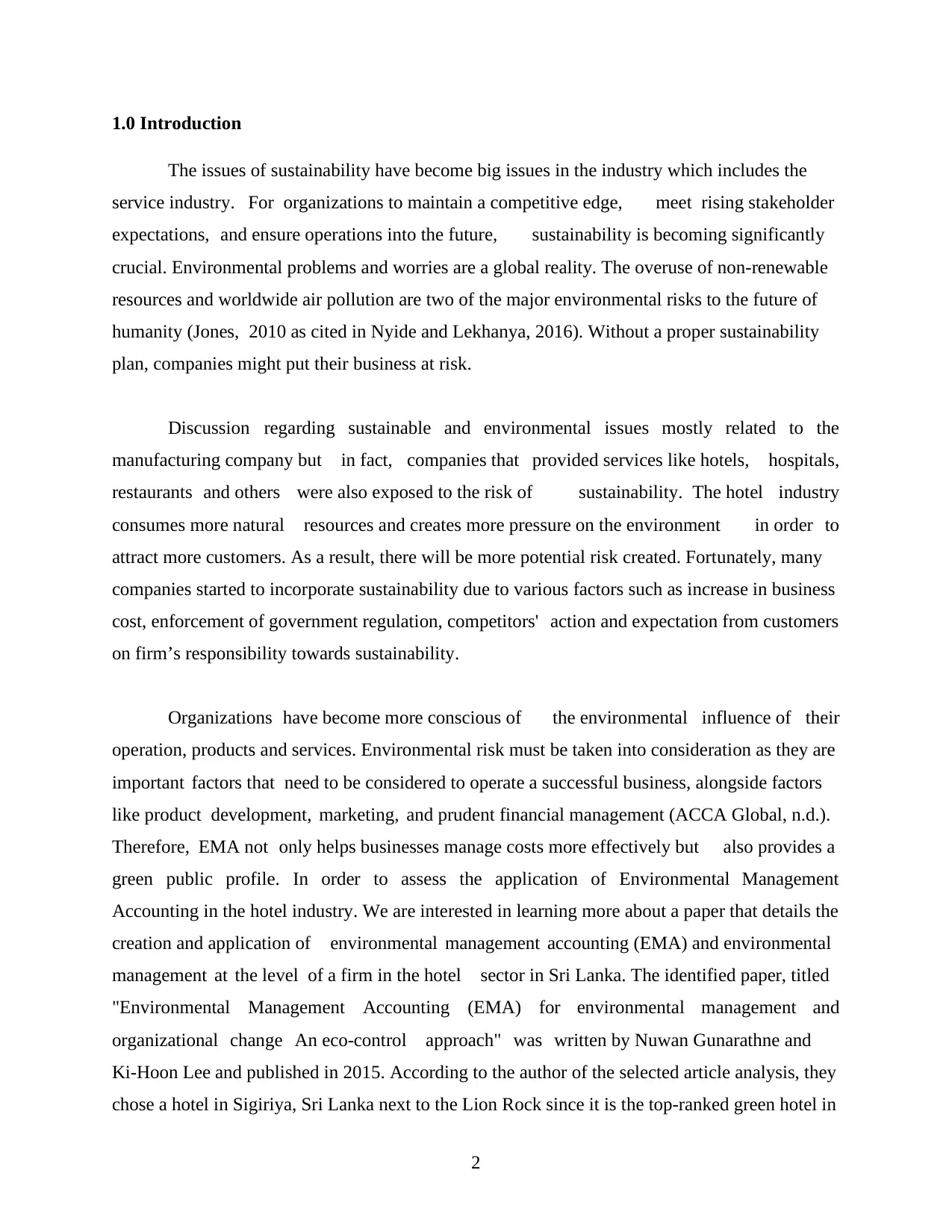
1.0 Introduction
The issues of sustainability have become big issues in the industry which includes the
service industry. For organizations to maintain a competitive edge, meet rising stakeholder
expectations, and ensure operations into the future, sustainability is becoming significantly
crucial. Environmental problems and worries are a global reality. The overuse of non-renewable
resources and worldwide air pollution are two of the major environmental risks to the future of
humanity (Jones, 2010 as cited in Nyide and Lekhanya, 2016). Without a proper sustainability
plan, companies might put their business at risk.
Discussion regarding sustainable and environmental issues mostly related to the
manufacturing company but in fact, companies that provided services like hotels, hospitals,
restaurants and others were also exposed to the risk of sustainability. The hotel industry
consumes more natural resources and creates more pressure on the environment in order to
attract more customers. As a result, there will be more potential risk created. Fortunately, many
companies started to incorporate sustainability due to various factors such as increase in business
cost, enforcement of government regulation, competitors' action and expectation from customers
on firm’s responsibility towards sustainability.
Organizations have become more conscious of the environmental influence of their
operation, products and services. Environmental risk must be taken into consideration as they are
important factors that need to be considered to operate a successful business, alongside factors
like product development, marketing, and prudent financial management (ACCA Global, n.d.).
Therefore, EMA not only helps businesses manage costs more effectively but also provides a
green public profile. In order to assess the application of Environmental Management
Accounting in the hotel industry. We are interested in learning more about a paper that details the
creation and application of environmental management accounting (EMA) and environmental
management at the level of a firm in the hotel sector in Sri Lanka. The identified paper, titled
"Environmental Management Accounting (EMA) for environmental management and
organizational change An eco-control approach" was written by Nuwan Gunarathne and
Ki-Hoon Lee and published in 2015. According to the author of the selected article analysis, they
chose a hotel in Sigiriya, Sri Lanka next to the Lion Rock since it is the top-ranked green hotel in
2
The issues of sustainability have become big issues in the industry which includes the
service industry. For organizations to maintain a competitive edge, meet rising stakeholder
expectations, and ensure operations into the future, sustainability is becoming significantly
crucial. Environmental problems and worries are a global reality. The overuse of non-renewable
resources and worldwide air pollution are two of the major environmental risks to the future of
humanity (Jones, 2010 as cited in Nyide and Lekhanya, 2016). Without a proper sustainability
plan, companies might put their business at risk.
Discussion regarding sustainable and environmental issues mostly related to the
manufacturing company but in fact, companies that provided services like hotels, hospitals,
restaurants and others were also exposed to the risk of sustainability. The hotel industry
consumes more natural resources and creates more pressure on the environment in order to
attract more customers. As a result, there will be more potential risk created. Fortunately, many
companies started to incorporate sustainability due to various factors such as increase in business
cost, enforcement of government regulation, competitors' action and expectation from customers
on firm’s responsibility towards sustainability.
Organizations have become more conscious of the environmental influence of their
operation, products and services. Environmental risk must be taken into consideration as they are
important factors that need to be considered to operate a successful business, alongside factors
like product development, marketing, and prudent financial management (ACCA Global, n.d.).
Therefore, EMA not only helps businesses manage costs more effectively but also provides a
green public profile. In order to assess the application of Environmental Management
Accounting in the hotel industry. We are interested in learning more about a paper that details the
creation and application of environmental management accounting (EMA) and environmental
management at the level of a firm in the hotel sector in Sri Lanka. The identified paper, titled
"Environmental Management Accounting (EMA) for environmental management and
organizational change An eco-control approach" was written by Nuwan Gunarathne and
Ki-Hoon Lee and published in 2015. According to the author of the selected article analysis, they
chose a hotel in Sigiriya, Sri Lanka next to the Lion Rock since it is the top-ranked green hotel in
2
⊘ This is a preview!⊘
Do you want full access?
Subscribe today to unlock all pages.

Trusted by 1+ million students worldwide
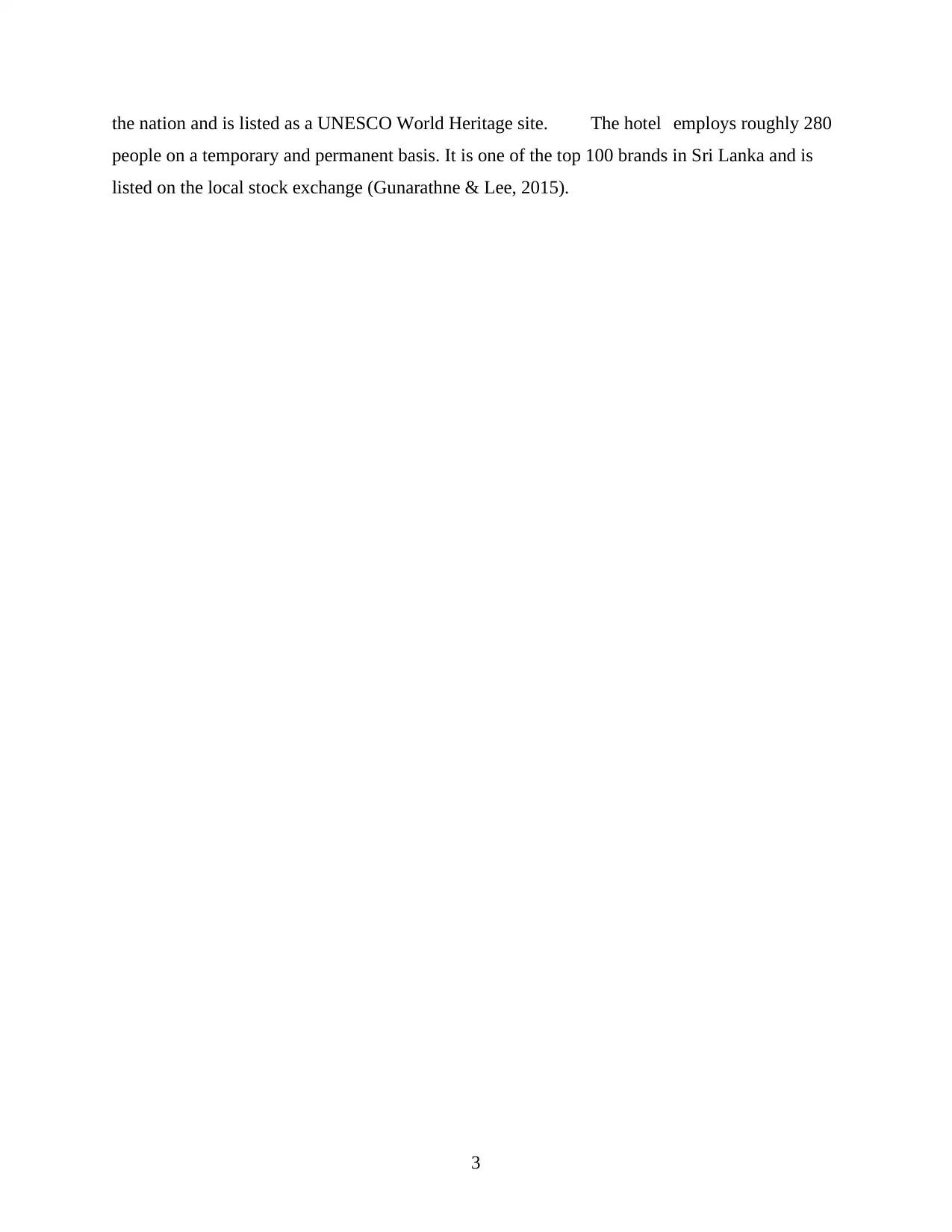
the nation and is listed as a UNESCO World Heritage site. The hotel employs roughly 280
people on a temporary and permanent basis. It is one of the top 100 brands in Sri Lanka and is
listed on the local stock exchange (Gunarathne & Lee, 2015).
3
people on a temporary and permanent basis. It is one of the top 100 brands in Sri Lanka and is
listed on the local stock exchange (Gunarathne & Lee, 2015).
3
Paraphrase This Document
Need a fresh take? Get an instant paraphrase of this document with our AI Paraphraser
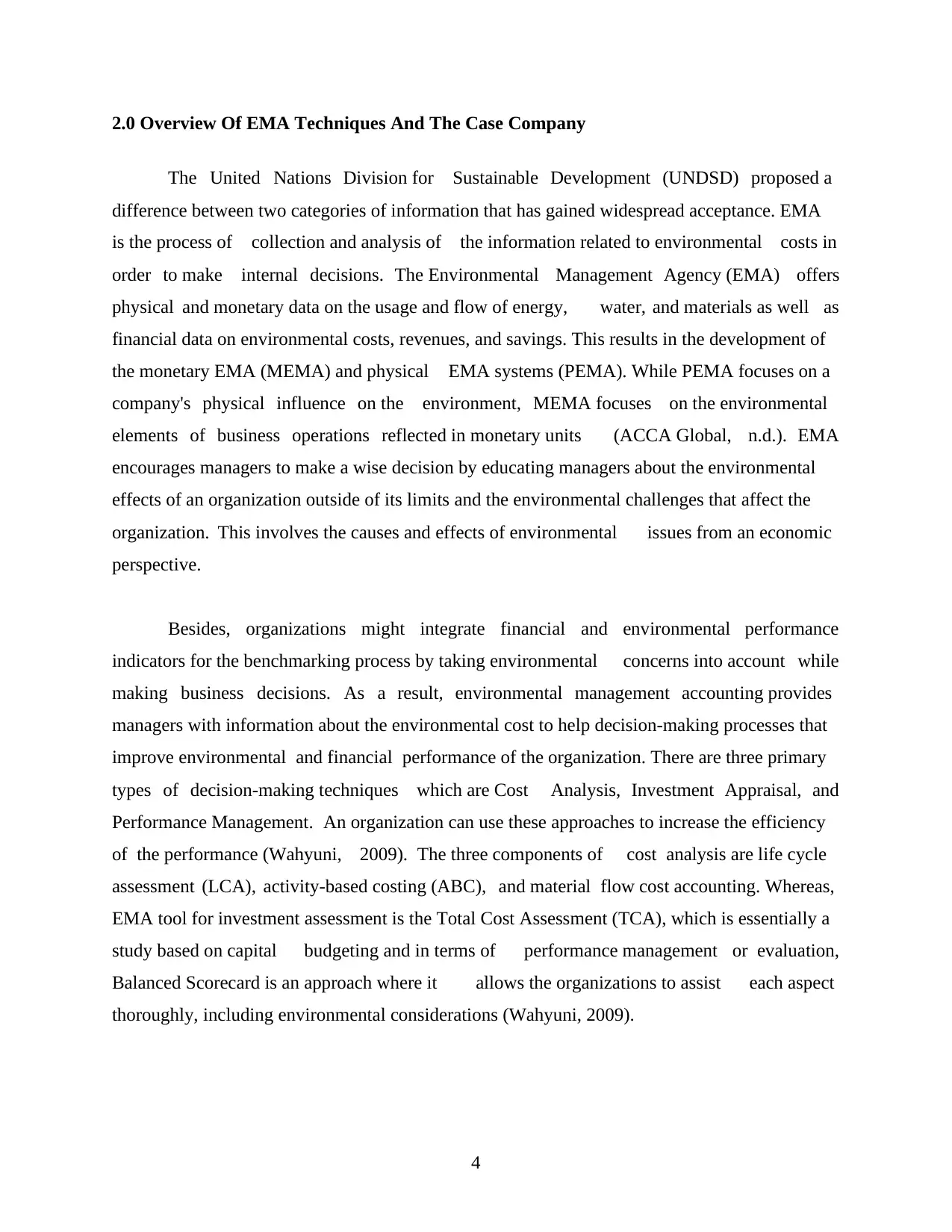
2.0 Overview Of EMA Techniques And The Case Company
The United Nations Division for Sustainable Development (UNDSD) proposed a
difference between two categories of information that has gained widespread acceptance. EMA
is the process of collection and analysis of the information related to environmental costs in
order to make internal decisions. The Environmental Management Agency (EMA) offers
physical and monetary data on the usage and flow of energy, water, and materials as well as
financial data on environmental costs, revenues, and savings. This results in the development of
the monetary EMA (MEMA) and physical EMA systems (PEMA). While PEMA focuses on a
company's physical influence on the environment, MEMA focuses on the environmental
elements of business operations reflected in monetary units (ACCA Global, n.d.). EMA
encourages managers to make a wise decision by educating managers about the environmental
effects of an organization outside of its limits and the environmental challenges that affect the
organization. This involves the causes and effects of environmental issues from an economic
perspective.
Besides, organizations might integrate financial and environmental performance
indicators for the benchmarking process by taking environmental concerns into account while
making business decisions. As a result, environmental management accounting provides
managers with information about the environmental cost to help decision-making processes that
improve environmental and financial performance of the organization. There are three primary
types of decision-making techniques which are Cost Analysis, Investment Appraisal, and
Performance Management. An organization can use these approaches to increase the efficiency
of the performance (Wahyuni, 2009). The three components of cost analysis are life cycle
assessment (LCA), activity-based costing (ABC), and material flow cost accounting. Whereas,
EMA tool for investment assessment is the Total Cost Assessment (TCA), which is essentially a
study based on capital budgeting and in terms of performance management or evaluation,
Balanced Scorecard is an approach where it allows the organizations to assist each aspect
thoroughly, including environmental considerations (Wahyuni, 2009).
4
The United Nations Division for Sustainable Development (UNDSD) proposed a
difference between two categories of information that has gained widespread acceptance. EMA
is the process of collection and analysis of the information related to environmental costs in
order to make internal decisions. The Environmental Management Agency (EMA) offers
physical and monetary data on the usage and flow of energy, water, and materials as well as
financial data on environmental costs, revenues, and savings. This results in the development of
the monetary EMA (MEMA) and physical EMA systems (PEMA). While PEMA focuses on a
company's physical influence on the environment, MEMA focuses on the environmental
elements of business operations reflected in monetary units (ACCA Global, n.d.). EMA
encourages managers to make a wise decision by educating managers about the environmental
effects of an organization outside of its limits and the environmental challenges that affect the
organization. This involves the causes and effects of environmental issues from an economic
perspective.
Besides, organizations might integrate financial and environmental performance
indicators for the benchmarking process by taking environmental concerns into account while
making business decisions. As a result, environmental management accounting provides
managers with information about the environmental cost to help decision-making processes that
improve environmental and financial performance of the organization. There are three primary
types of decision-making techniques which are Cost Analysis, Investment Appraisal, and
Performance Management. An organization can use these approaches to increase the efficiency
of the performance (Wahyuni, 2009). The three components of cost analysis are life cycle
assessment (LCA), activity-based costing (ABC), and material flow cost accounting. Whereas,
EMA tool for investment assessment is the Total Cost Assessment (TCA), which is essentially a
study based on capital budgeting and in terms of performance management or evaluation,
Balanced Scorecard is an approach where it allows the organizations to assist each aspect
thoroughly, including environmental considerations (Wahyuni, 2009).
4
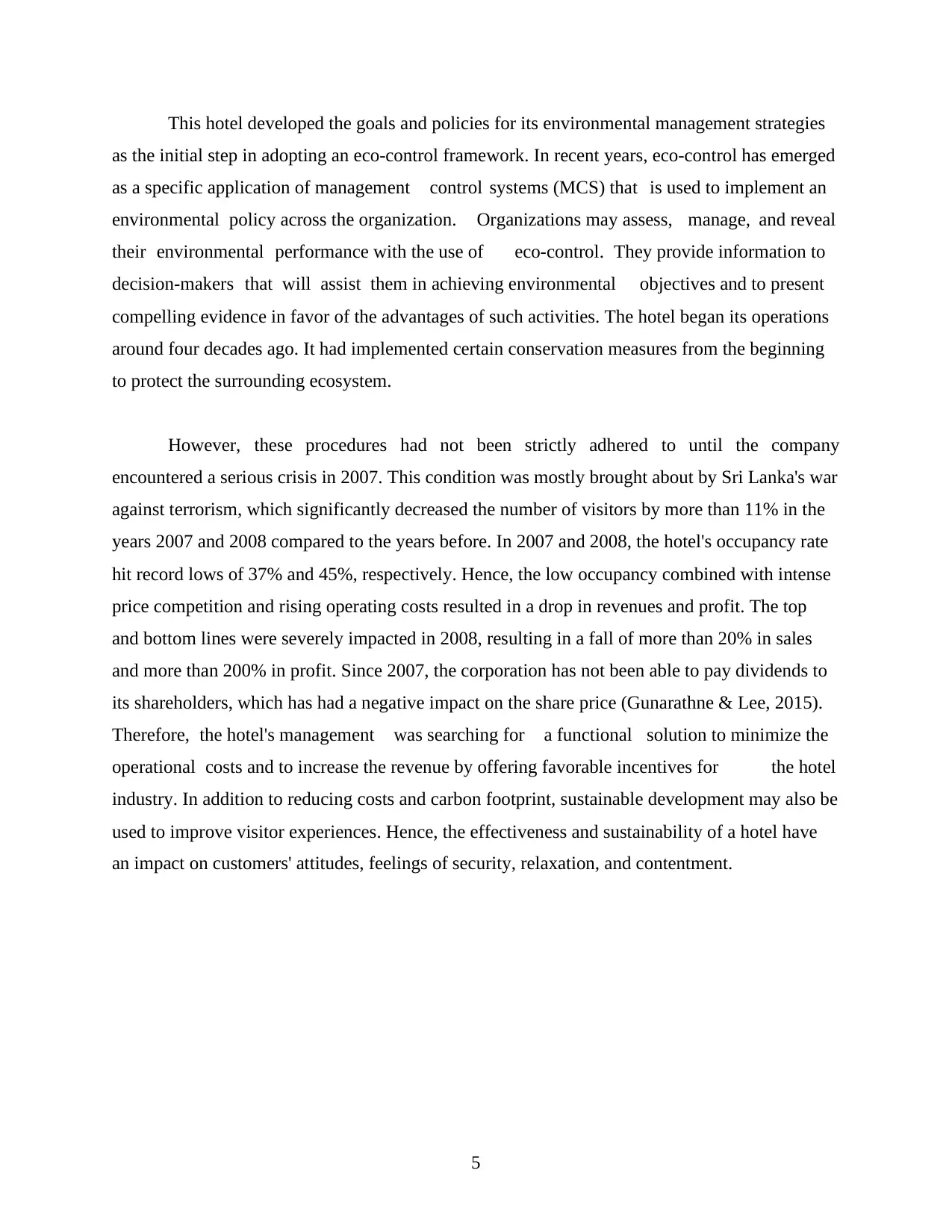
This hotel developed the goals and policies for its environmental management strategies
as the initial step in adopting an eco-control framework. In recent years, eco-control has emerged
as a specific application of management control systems (MCS) that is used to implement an
environmental policy across the organization. Organizations may assess, manage, and reveal
their environmental performance with the use of eco-control. They provide information to
decision-makers that will assist them in achieving environmental objectives and to present
compelling evidence in favor of the advantages of such activities. The hotel began its operations
around four decades ago. It had implemented certain conservation measures from the beginning
to protect the surrounding ecosystem.
However, these procedures had not been strictly adhered to until the company
encountered a serious crisis in 2007. This condition was mostly brought about by Sri Lanka's war
against terrorism, which significantly decreased the number of visitors by more than 11% in the
years 2007 and 2008 compared to the years before. In 2007 and 2008, the hotel's occupancy rate
hit record lows of 37% and 45%, respectively. Hence, the low occupancy combined with intense
price competition and rising operating costs resulted in a drop in revenues and profit. The top
and bottom lines were severely impacted in 2008, resulting in a fall of more than 20% in sales
and more than 200% in profit. Since 2007, the corporation has not been able to pay dividends to
its shareholders, which has had a negative impact on the share price (Gunarathne & Lee, 2015).
Therefore, the hotel's management was searching for a functional solution to minimize the
operational costs and to increase the revenue by offering favorable incentives for the hotel
industry. In addition to reducing costs and carbon footprint, sustainable development may also be
used to improve visitor experiences. Hence, the effectiveness and sustainability of a hotel have
an impact on customers' attitudes, feelings of security, relaxation, and contentment.
5
as the initial step in adopting an eco-control framework. In recent years, eco-control has emerged
as a specific application of management control systems (MCS) that is used to implement an
environmental policy across the organization. Organizations may assess, manage, and reveal
their environmental performance with the use of eco-control. They provide information to
decision-makers that will assist them in achieving environmental objectives and to present
compelling evidence in favor of the advantages of such activities. The hotel began its operations
around four decades ago. It had implemented certain conservation measures from the beginning
to protect the surrounding ecosystem.
However, these procedures had not been strictly adhered to until the company
encountered a serious crisis in 2007. This condition was mostly brought about by Sri Lanka's war
against terrorism, which significantly decreased the number of visitors by more than 11% in the
years 2007 and 2008 compared to the years before. In 2007 and 2008, the hotel's occupancy rate
hit record lows of 37% and 45%, respectively. Hence, the low occupancy combined with intense
price competition and rising operating costs resulted in a drop in revenues and profit. The top
and bottom lines were severely impacted in 2008, resulting in a fall of more than 20% in sales
and more than 200% in profit. Since 2007, the corporation has not been able to pay dividends to
its shareholders, which has had a negative impact on the share price (Gunarathne & Lee, 2015).
Therefore, the hotel's management was searching for a functional solution to minimize the
operational costs and to increase the revenue by offering favorable incentives for the hotel
industry. In addition to reducing costs and carbon footprint, sustainable development may also be
used to improve visitor experiences. Hence, the effectiveness and sustainability of a hotel have
an impact on customers' attitudes, feelings of security, relaxation, and contentment.
5
⊘ This is a preview!⊘
Do you want full access?
Subscribe today to unlock all pages.

Trusted by 1+ million students worldwide

3.0 Implementation of the EMA Technique at the Case Company
According to the integrated eco-control framework, the author highlights three stages in
the case firm's adoption of EMA in corporate environmental strategy (Gunarathne & Lee, 2015):
1. How the hotel adopted EMA;
2. How conservation efforts resulted in cost savings; and
3. How the EMA approaches were implemented into the organization's daily
operations.
Goal and policy formulation
The management created a plan to enhance the hotel's green hotel concept while saving
money. This initiative aimed to promote ecotourism by incorporating it into hotel operations. The
hotel's environmental policy has the following goals (Gunarathne & Lee, 2015):
● save water and energy;
● decrease air pollution, solid waste and chemical pollution;
● increase practices for reducing, recycling and reusing;
● increase the use of materials that environment-friendly;
● increase the use of indigenous flora landscaping and remove invasive alien
species; and
● promote local livelihoods and save biodiversity.
Implementation
During the survival phase, the area of energy and water practices were created because
they offered great cost-saving possibilities. Management recognised after studying operating
expenses that energy expenditures are the most critical. So, they focused on electricity and other
energy sources to save the cost.
To create a thorough energy conservation plan, the hotel came up with several initiatives.
These included putting up solar panels to heat water, installing card key switches for room air
conditioning, setting up a schedule for turning lights on and off, giving each light switch a
6
According to the integrated eco-control framework, the author highlights three stages in
the case firm's adoption of EMA in corporate environmental strategy (Gunarathne & Lee, 2015):
1. How the hotel adopted EMA;
2. How conservation efforts resulted in cost savings; and
3. How the EMA approaches were implemented into the organization's daily
operations.
Goal and policy formulation
The management created a plan to enhance the hotel's green hotel concept while saving
money. This initiative aimed to promote ecotourism by incorporating it into hotel operations. The
hotel's environmental policy has the following goals (Gunarathne & Lee, 2015):
● save water and energy;
● decrease air pollution, solid waste and chemical pollution;
● increase practices for reducing, recycling and reusing;
● increase the use of materials that environment-friendly;
● increase the use of indigenous flora landscaping and remove invasive alien
species; and
● promote local livelihoods and save biodiversity.
Implementation
During the survival phase, the area of energy and water practices were created because
they offered great cost-saving possibilities. Management recognised after studying operating
expenses that energy expenditures are the most critical. So, they focused on electricity and other
energy sources to save the cost.
To create a thorough energy conservation plan, the hotel came up with several initiatives.
These included putting up solar panels to heat water, installing card key switches for room air
conditioning, setting up a schedule for turning lights on and off, giving each light switch a
6
Paraphrase This Document
Need a fresh take? Get an instant paraphrase of this document with our AI Paraphraser
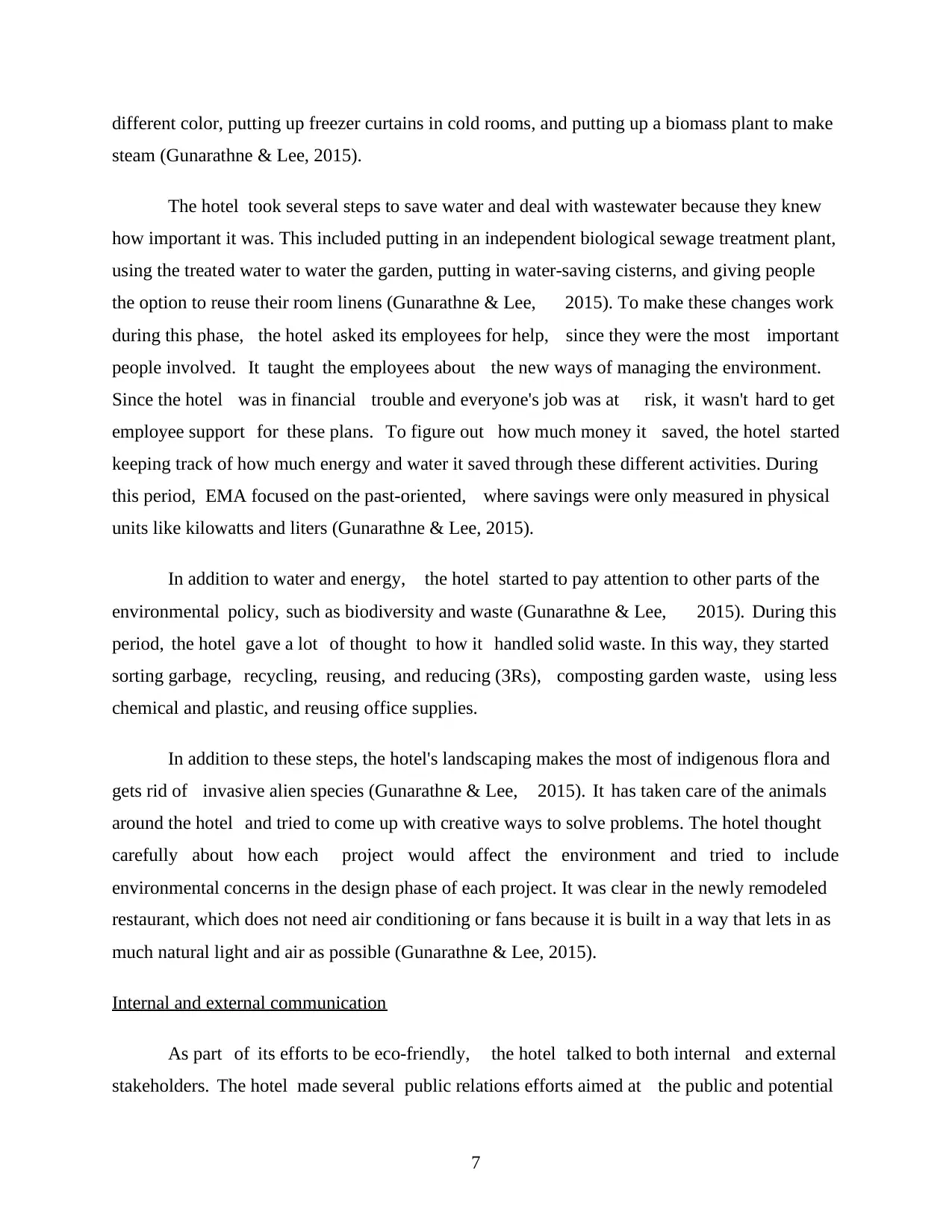
different color, putting up freezer curtains in cold rooms, and putting up a biomass plant to make
steam (Gunarathne & Lee, 2015).
The hotel took several steps to save water and deal with wastewater because they knew
how important it was. This included putting in an independent biological sewage treatment plant,
using the treated water to water the garden, putting in water-saving cisterns, and giving people
the option to reuse their room linens (Gunarathne & Lee, 2015). To make these changes work
during this phase, the hotel asked its employees for help, since they were the most important
people involved. It taught the employees about the new ways of managing the environment.
Since the hotel was in financial trouble and everyone's job was at risk, it wasn't hard to get
employee support for these plans. To figure out how much money it saved, the hotel started
keeping track of how much energy and water it saved through these different activities. During
this period, EMA focused on the past-oriented, where savings were only measured in physical
units like kilowatts and liters (Gunarathne & Lee, 2015).
In addition to water and energy, the hotel started to pay attention to other parts of the
environmental policy, such as biodiversity and waste (Gunarathne & Lee, 2015). During this
period, the hotel gave a lot of thought to how it handled solid waste. In this way, they started
sorting garbage, recycling, reusing, and reducing (3Rs), composting garden waste, using less
chemical and plastic, and reusing office supplies.
In addition to these steps, the hotel's landscaping makes the most of indigenous flora and
gets rid of invasive alien species (Gunarathne & Lee, 2015). It has taken care of the animals
around the hotel and tried to come up with creative ways to solve problems. The hotel thought
carefully about how each project would affect the environment and tried to include
environmental concerns in the design phase of each project. It was clear in the newly remodeled
restaurant, which does not need air conditioning or fans because it is built in a way that lets in as
much natural light and air as possible (Gunarathne & Lee, 2015).
Internal and external communication
As part of its efforts to be eco-friendly, the hotel talked to both internal and external
stakeholders. The hotel made several public relations efforts aimed at the public and potential
7
steam (Gunarathne & Lee, 2015).
The hotel took several steps to save water and deal with wastewater because they knew
how important it was. This included putting in an independent biological sewage treatment plant,
using the treated water to water the garden, putting in water-saving cisterns, and giving people
the option to reuse their room linens (Gunarathne & Lee, 2015). To make these changes work
during this phase, the hotel asked its employees for help, since they were the most important
people involved. It taught the employees about the new ways of managing the environment.
Since the hotel was in financial trouble and everyone's job was at risk, it wasn't hard to get
employee support for these plans. To figure out how much money it saved, the hotel started
keeping track of how much energy and water it saved through these different activities. During
this period, EMA focused on the past-oriented, where savings were only measured in physical
units like kilowatts and liters (Gunarathne & Lee, 2015).
In addition to water and energy, the hotel started to pay attention to other parts of the
environmental policy, such as biodiversity and waste (Gunarathne & Lee, 2015). During this
period, the hotel gave a lot of thought to how it handled solid waste. In this way, they started
sorting garbage, recycling, reusing, and reducing (3Rs), composting garden waste, using less
chemical and plastic, and reusing office supplies.
In addition to these steps, the hotel's landscaping makes the most of indigenous flora and
gets rid of invasive alien species (Gunarathne & Lee, 2015). It has taken care of the animals
around the hotel and tried to come up with creative ways to solve problems. The hotel thought
carefully about how each project would affect the environment and tried to include
environmental concerns in the design phase of each project. It was clear in the newly remodeled
restaurant, which does not need air conditioning or fans because it is built in a way that lets in as
much natural light and air as possible (Gunarathne & Lee, 2015).
Internal and external communication
As part of its efforts to be eco-friendly, the hotel talked to both internal and external
stakeholders. The hotel made several public relations efforts aimed at the public and potential
7
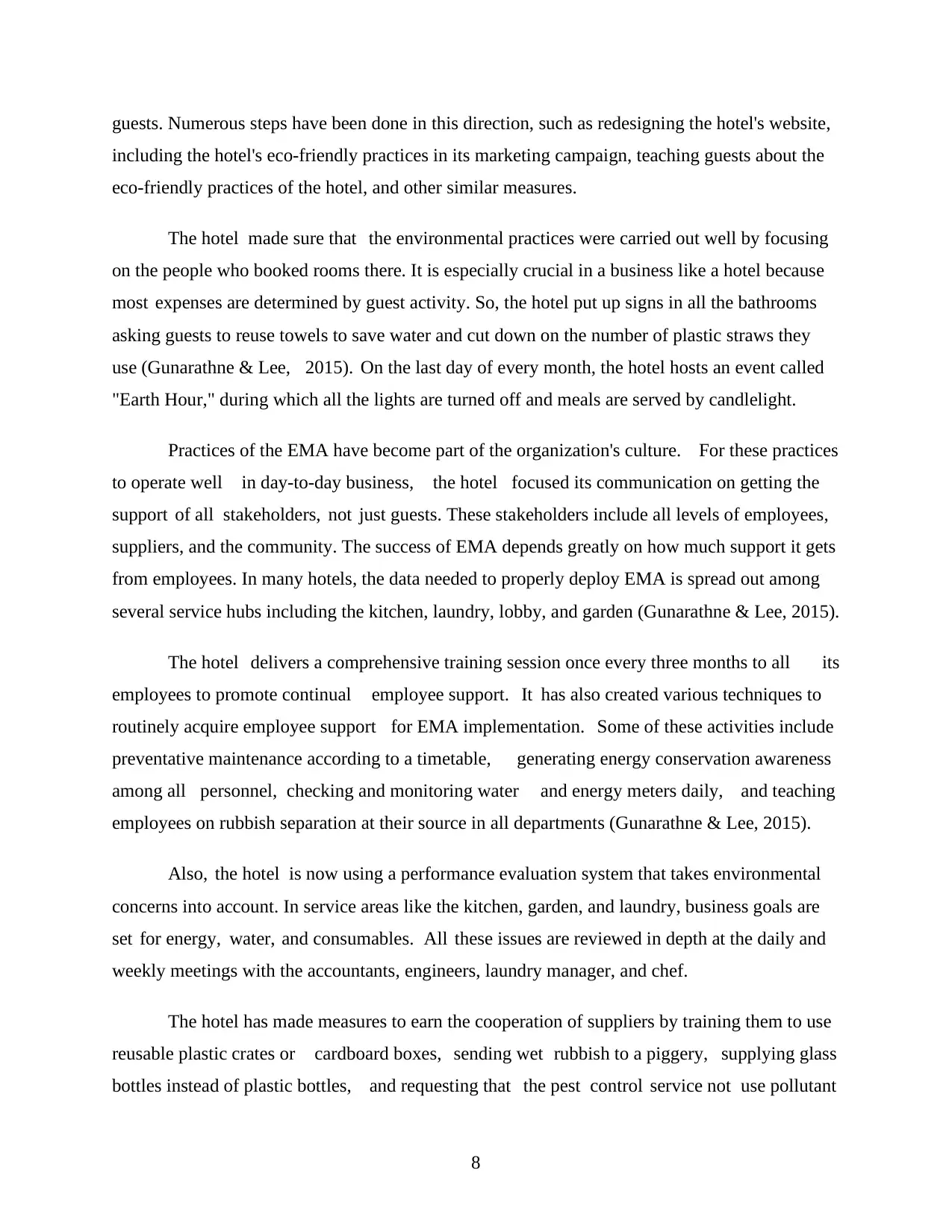
guests. Numerous steps have been done in this direction, such as redesigning the hotel's website,
including the hotel's eco-friendly practices in its marketing campaign, teaching guests about the
eco-friendly practices of the hotel, and other similar measures.
The hotel made sure that the environmental practices were carried out well by focusing
on the people who booked rooms there. It is especially crucial in a business like a hotel because
most expenses are determined by guest activity. So, the hotel put up signs in all the bathrooms
asking guests to reuse towels to save water and cut down on the number of plastic straws they
use (Gunarathne & Lee, 2015). On the last day of every month, the hotel hosts an event called
"Earth Hour," during which all the lights are turned off and meals are served by candlelight.
Practices of the EMA have become part of the organization's culture. For these practices
to operate well in day-to-day business, the hotel focused its communication on getting the
support of all stakeholders, not just guests. These stakeholders include all levels of employees,
suppliers, and the community. The success of EMA depends greatly on how much support it gets
from employees. In many hotels, the data needed to properly deploy EMA is spread out among
several service hubs including the kitchen, laundry, lobby, and garden (Gunarathne & Lee, 2015).
The hotel delivers a comprehensive training session once every three months to all its
employees to promote continual employee support. It has also created various techniques to
routinely acquire employee support for EMA implementation. Some of these activities include
preventative maintenance according to a timetable, generating energy conservation awareness
among all personnel, checking and monitoring water and energy meters daily, and teaching
employees on rubbish separation at their source in all departments (Gunarathne & Lee, 2015).
Also, the hotel is now using a performance evaluation system that takes environmental
concerns into account. In service areas like the kitchen, garden, and laundry, business goals are
set for energy, water, and consumables. All these issues are reviewed in depth at the daily and
weekly meetings with the accountants, engineers, laundry manager, and chef.
The hotel has made measures to earn the cooperation of suppliers by training them to use
reusable plastic crates or cardboard boxes, sending wet rubbish to a piggery, supplying glass
bottles instead of plastic bottles, and requesting that the pest control service not use pollutant
8
including the hotel's eco-friendly practices in its marketing campaign, teaching guests about the
eco-friendly practices of the hotel, and other similar measures.
The hotel made sure that the environmental practices were carried out well by focusing
on the people who booked rooms there. It is especially crucial in a business like a hotel because
most expenses are determined by guest activity. So, the hotel put up signs in all the bathrooms
asking guests to reuse towels to save water and cut down on the number of plastic straws they
use (Gunarathne & Lee, 2015). On the last day of every month, the hotel hosts an event called
"Earth Hour," during which all the lights are turned off and meals are served by candlelight.
Practices of the EMA have become part of the organization's culture. For these practices
to operate well in day-to-day business, the hotel focused its communication on getting the
support of all stakeholders, not just guests. These stakeholders include all levels of employees,
suppliers, and the community. The success of EMA depends greatly on how much support it gets
from employees. In many hotels, the data needed to properly deploy EMA is spread out among
several service hubs including the kitchen, laundry, lobby, and garden (Gunarathne & Lee, 2015).
The hotel delivers a comprehensive training session once every three months to all its
employees to promote continual employee support. It has also created various techniques to
routinely acquire employee support for EMA implementation. Some of these activities include
preventative maintenance according to a timetable, generating energy conservation awareness
among all personnel, checking and monitoring water and energy meters daily, and teaching
employees on rubbish separation at their source in all departments (Gunarathne & Lee, 2015).
Also, the hotel is now using a performance evaluation system that takes environmental
concerns into account. In service areas like the kitchen, garden, and laundry, business goals are
set for energy, water, and consumables. All these issues are reviewed in depth at the daily and
weekly meetings with the accountants, engineers, laundry manager, and chef.
The hotel has made measures to earn the cooperation of suppliers by training them to use
reusable plastic crates or cardboard boxes, sending wet rubbish to a piggery, supplying glass
bottles instead of plastic bottles, and requesting that the pest control service not use pollutant
8
⊘ This is a preview!⊘
Do you want full access?
Subscribe today to unlock all pages.

Trusted by 1+ million students worldwide
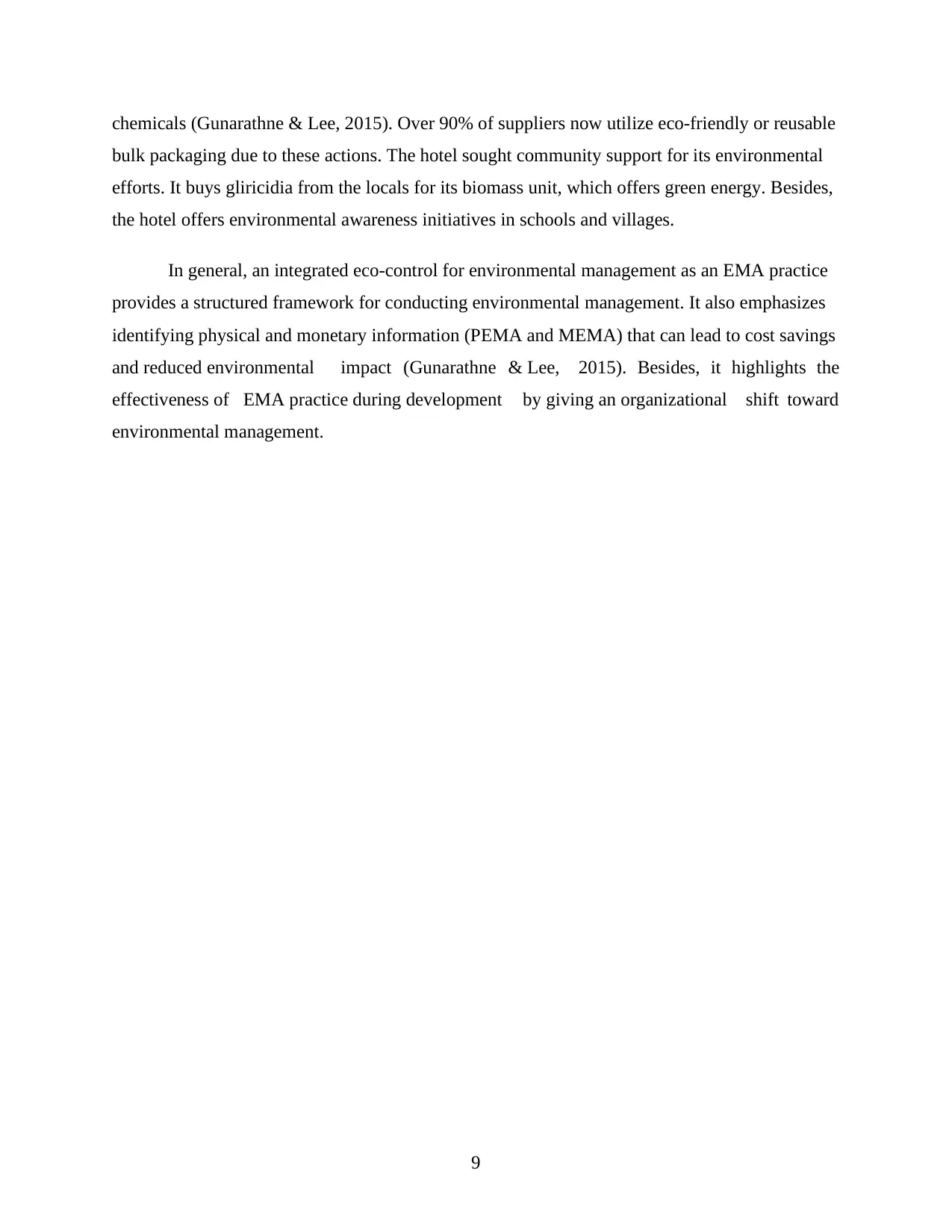
chemicals (Gunarathne & Lee, 2015). Over 90% of suppliers now utilize eco-friendly or reusable
bulk packaging due to these actions. The hotel sought community support for its environmental
efforts. It buys gliricidia from the locals for its biomass unit, which offers green energy. Besides,
the hotel offers environmental awareness initiatives in schools and villages.
In general, an integrated eco-control for environmental management as an EMA practice
provides a structured framework for conducting environmental management. It also emphasizes
identifying physical and monetary information (PEMA and MEMA) that can lead to cost savings
and reduced environmental impact (Gunarathne & Lee, 2015). Besides, it highlights the
effectiveness of EMA practice during development by giving an organizational shift toward
environmental management.
9
bulk packaging due to these actions. The hotel sought community support for its environmental
efforts. It buys gliricidia from the locals for its biomass unit, which offers green energy. Besides,
the hotel offers environmental awareness initiatives in schools and villages.
In general, an integrated eco-control for environmental management as an EMA practice
provides a structured framework for conducting environmental management. It also emphasizes
identifying physical and monetary information (PEMA and MEMA) that can lead to cost savings
and reduced environmental impact (Gunarathne & Lee, 2015). Besides, it highlights the
effectiveness of EMA practice during development by giving an organizational shift toward
environmental management.
9
Paraphrase This Document
Need a fresh take? Get an instant paraphrase of this document with our AI Paraphraser
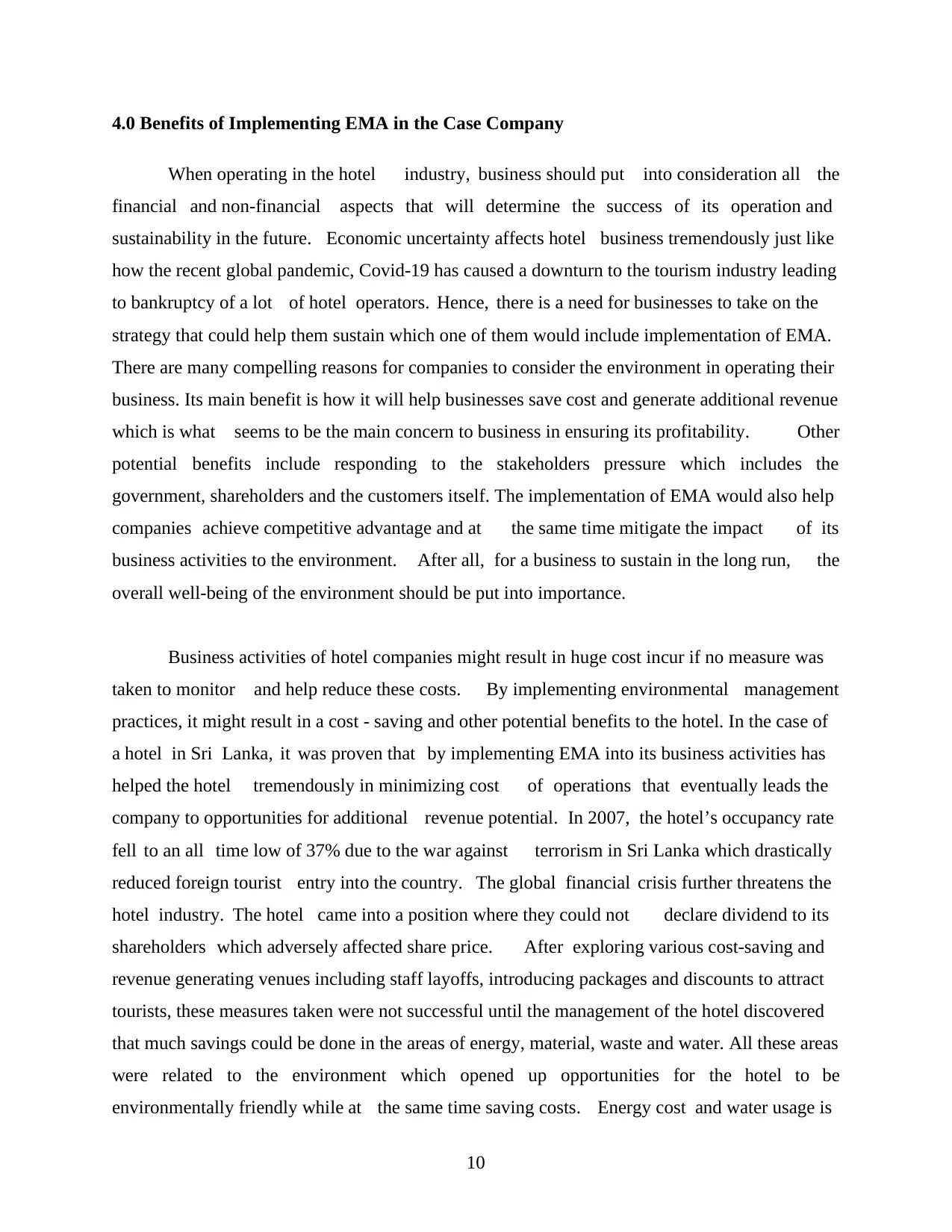
4.0 Benefits of Implementing EMA in the Case Company
When operating in the hotel industry, business should put into consideration all the
financial and non-financial aspects that will determine the success of its operation and
sustainability in the future. Economic uncertainty affects hotel business tremendously just like
how the recent global pandemic, Covid-19 has caused a downturn to the tourism industry leading
to bankruptcy of a lot of hotel operators. Hence, there is a need for businesses to take on the
strategy that could help them sustain which one of them would include implementation of EMA.
There are many compelling reasons for companies to consider the environment in operating their
business. Its main benefit is how it will help businesses save cost and generate additional revenue
which is what seems to be the main concern to business in ensuring its profitability. Other
potential benefits include responding to the stakeholders pressure which includes the
government, shareholders and the customers itself. The implementation of EMA would also help
companies achieve competitive advantage and at the same time mitigate the impact of its
business activities to the environment. After all, for a business to sustain in the long run, the
overall well-being of the environment should be put into importance.
Business activities of hotel companies might result in huge cost incur if no measure was
taken to monitor and help reduce these costs. By implementing environmental management
practices, it might result in a cost - saving and other potential benefits to the hotel. In the case of
a hotel in Sri Lanka, it was proven that by implementing EMA into its business activities has
helped the hotel tremendously in minimizing cost of operations that eventually leads the
company to opportunities for additional revenue potential. In 2007, the hotel’s occupancy rate
fell to an all time low of 37% due to the war against terrorism in Sri Lanka which drastically
reduced foreign tourist entry into the country. The global financial crisis further threatens the
hotel industry. The hotel came into a position where they could not declare dividend to its
shareholders which adversely affected share price. After exploring various cost-saving and
revenue generating venues including staff layoffs, introducing packages and discounts to attract
tourists, these measures taken were not successful until the management of the hotel discovered
that much savings could be done in the areas of energy, material, waste and water. All these areas
were related to the environment which opened up opportunities for the hotel to be
environmentally friendly while at the same time saving costs. Energy cost and water usage is
10
When operating in the hotel industry, business should put into consideration all the
financial and non-financial aspects that will determine the success of its operation and
sustainability in the future. Economic uncertainty affects hotel business tremendously just like
how the recent global pandemic, Covid-19 has caused a downturn to the tourism industry leading
to bankruptcy of a lot of hotel operators. Hence, there is a need for businesses to take on the
strategy that could help them sustain which one of them would include implementation of EMA.
There are many compelling reasons for companies to consider the environment in operating their
business. Its main benefit is how it will help businesses save cost and generate additional revenue
which is what seems to be the main concern to business in ensuring its profitability. Other
potential benefits include responding to the stakeholders pressure which includes the
government, shareholders and the customers itself. The implementation of EMA would also help
companies achieve competitive advantage and at the same time mitigate the impact of its
business activities to the environment. After all, for a business to sustain in the long run, the
overall well-being of the environment should be put into importance.
Business activities of hotel companies might result in huge cost incur if no measure was
taken to monitor and help reduce these costs. By implementing environmental management
practices, it might result in a cost - saving and other potential benefits to the hotel. In the case of
a hotel in Sri Lanka, it was proven that by implementing EMA into its business activities has
helped the hotel tremendously in minimizing cost of operations that eventually leads the
company to opportunities for additional revenue potential. In 2007, the hotel’s occupancy rate
fell to an all time low of 37% due to the war against terrorism in Sri Lanka which drastically
reduced foreign tourist entry into the country. The global financial crisis further threatens the
hotel industry. The hotel came into a position where they could not declare dividend to its
shareholders which adversely affected share price. After exploring various cost-saving and
revenue generating venues including staff layoffs, introducing packages and discounts to attract
tourists, these measures taken were not successful until the management of the hotel discovered
that much savings could be done in the areas of energy, material, waste and water. All these areas
were related to the environment which opened up opportunities for the hotel to be
environmentally friendly while at the same time saving costs. Energy cost and water usage is
10
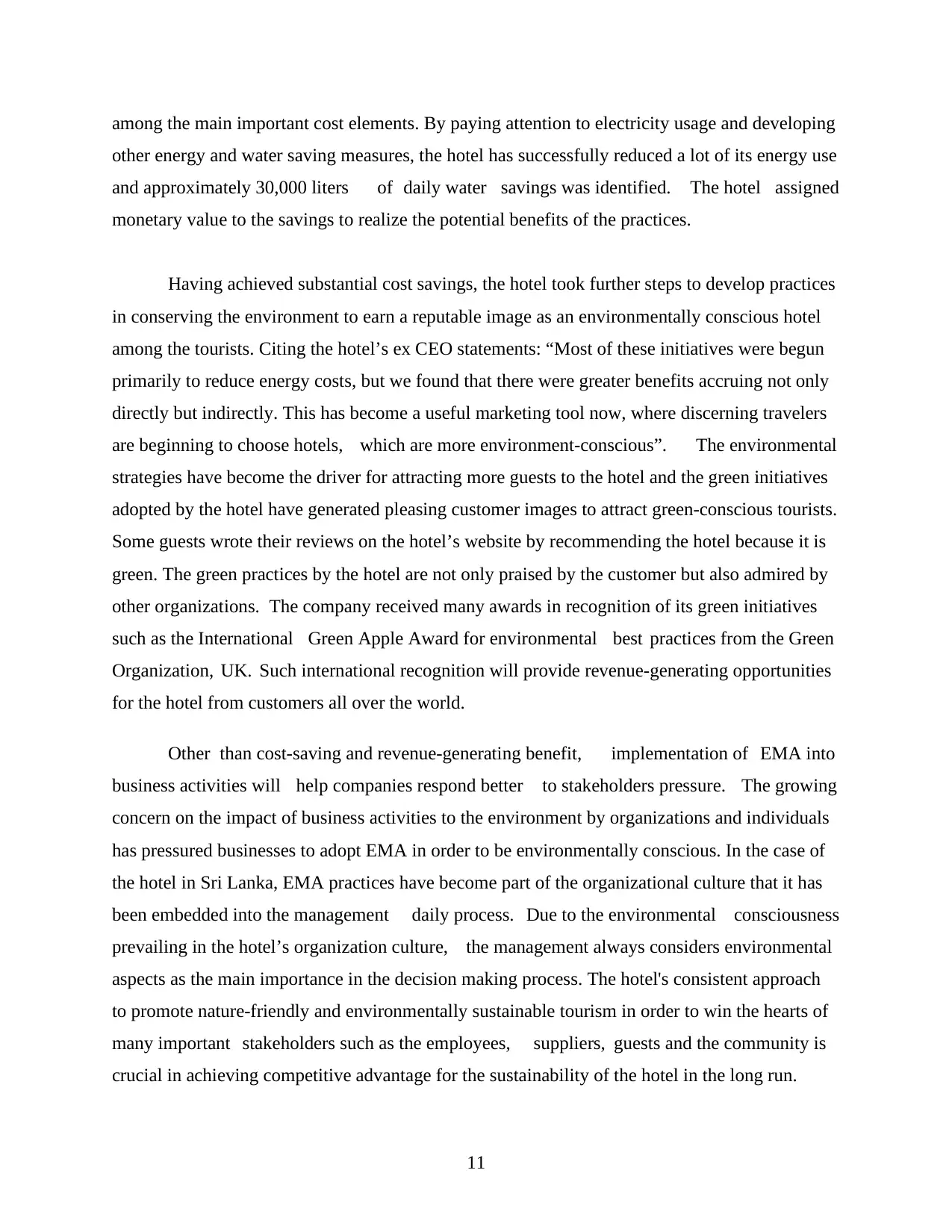
among the main important cost elements. By paying attention to electricity usage and developing
other energy and water saving measures, the hotel has successfully reduced a lot of its energy use
and approximately 30,000 liters of daily water savings was identified. The hotel assigned
monetary value to the savings to realize the potential benefits of the practices.
Having achieved substantial cost savings, the hotel took further steps to develop practices
in conserving the environment to earn a reputable image as an environmentally conscious hotel
among the tourists. Citing the hotel’s ex CEO statements: “Most of these initiatives were begun
primarily to reduce energy costs, but we found that there were greater benefits accruing not only
directly but indirectly. This has become a useful marketing tool now, where discerning travelers
are beginning to choose hotels, which are more environment-conscious”. The environmental
strategies have become the driver for attracting more guests to the hotel and the green initiatives
adopted by the hotel have generated pleasing customer images to attract green-conscious tourists.
Some guests wrote their reviews on the hotel’s website by recommending the hotel because it is
green. The green practices by the hotel are not only praised by the customer but also admired by
other organizations. The company received many awards in recognition of its green initiatives
such as the International Green Apple Award for environmental best practices from the Green
Organization, UK. Such international recognition will provide revenue-generating opportunities
for the hotel from customers all over the world.
Other than cost-saving and revenue-generating benefit, implementation of EMA into
business activities will help companies respond better to stakeholders pressure. The growing
concern on the impact of business activities to the environment by organizations and individuals
has pressured businesses to adopt EMA in order to be environmentally conscious. In the case of
the hotel in Sri Lanka, EMA practices have become part of the organizational culture that it has
been embedded into the management daily process. Due to the environmental consciousness
prevailing in the hotel’s organization culture, the management always considers environmental
aspects as the main importance in the decision making process. The hotel's consistent approach
to promote nature-friendly and environmentally sustainable tourism in order to win the hearts of
many important stakeholders such as the employees, suppliers, guests and the community is
crucial in achieving competitive advantage for the sustainability of the hotel in the long run.
11
other energy and water saving measures, the hotel has successfully reduced a lot of its energy use
and approximately 30,000 liters of daily water savings was identified. The hotel assigned
monetary value to the savings to realize the potential benefits of the practices.
Having achieved substantial cost savings, the hotel took further steps to develop practices
in conserving the environment to earn a reputable image as an environmentally conscious hotel
among the tourists. Citing the hotel’s ex CEO statements: “Most of these initiatives were begun
primarily to reduce energy costs, but we found that there were greater benefits accruing not only
directly but indirectly. This has become a useful marketing tool now, where discerning travelers
are beginning to choose hotels, which are more environment-conscious”. The environmental
strategies have become the driver for attracting more guests to the hotel and the green initiatives
adopted by the hotel have generated pleasing customer images to attract green-conscious tourists.
Some guests wrote their reviews on the hotel’s website by recommending the hotel because it is
green. The green practices by the hotel are not only praised by the customer but also admired by
other organizations. The company received many awards in recognition of its green initiatives
such as the International Green Apple Award for environmental best practices from the Green
Organization, UK. Such international recognition will provide revenue-generating opportunities
for the hotel from customers all over the world.
Other than cost-saving and revenue-generating benefit, implementation of EMA into
business activities will help companies respond better to stakeholders pressure. The growing
concern on the impact of business activities to the environment by organizations and individuals
has pressured businesses to adopt EMA in order to be environmentally conscious. In the case of
the hotel in Sri Lanka, EMA practices have become part of the organizational culture that it has
been embedded into the management daily process. Due to the environmental consciousness
prevailing in the hotel’s organization culture, the management always considers environmental
aspects as the main importance in the decision making process. The hotel's consistent approach
to promote nature-friendly and environmentally sustainable tourism in order to win the hearts of
many important stakeholders such as the employees, suppliers, guests and the community is
crucial in achieving competitive advantage for the sustainability of the hotel in the long run.
11
⊘ This is a preview!⊘
Do you want full access?
Subscribe today to unlock all pages.

Trusted by 1+ million students worldwide
1 out of 21
Related Documents
Your All-in-One AI-Powered Toolkit for Academic Success.
+13062052269
info@desklib.com
Available 24*7 on WhatsApp / Email
![[object Object]](/_next/static/media/star-bottom.7253800d.svg)
Unlock your academic potential
Copyright © 2020–2026 A2Z Services. All Rights Reserved. Developed and managed by ZUCOL.





